Your cart is empty
Free shipping on all US orders


Free shipping on all orders
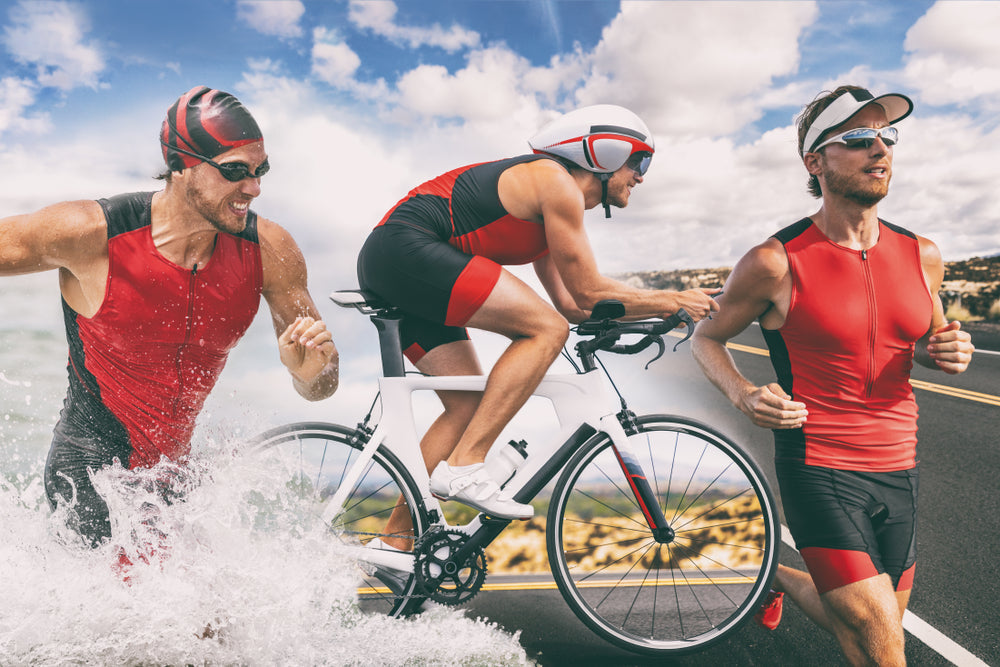
A triathlon is a complex athletic competition meticulously crafted to test athletes across three distinct disciplines: swimming, cycling, and running. This endurance challenge involves consecutive stages, starting with swimming, followed by cycling, and concluding with running.
Competitors must seamlessly transition between these activities without pause, adapting quickly to diverse physical demands. The triathlon's appeal lies not only in its physical rigor but also in the mental toughness it builds, making it attractive to those seeking to push their limits.
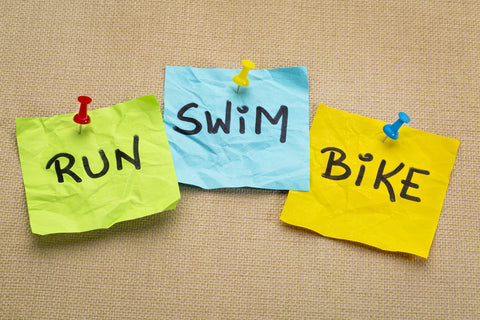
For novices, the triathlon offers a variety of enticing aspects. Initially, it presents a captivating mix of activities, avoiding the monotony often found in single-discipline sports. This diversity promotes comprehensive physical conditioning, improving cardiovascular health, muscle strength, and endurance simultaneously. Additionally, triathlon communities are known for their inclusive and supportive atmosphere, welcoming newcomers with open arms. This sense of camaraderie, combined with the personal satisfaction of completing the race, significantly boosts self-confidence and fosters a profound sense of achievement.
This blog post serves as a thorough guide for individuals embarking on their triathlon journey. Its goal is to demystify the sport for beginners, providing insights into each stage of the triathlon and practical advice on preparing for the first event. From training techniques and gear suggestions to strategies for smooth transitions between disciplines, this post aims to arm readers with the knowledge and confidence needed to tackle their inaugural triathlon.
Whether drawn to the sport for its physical challenges, mental resilience, or vibrant community, this guide illuminates the path to becoming a triathlete. By embracing the triathlon's multifaceted nature, participants embark on a transformative journey that transcends physical limits, builds resilience, and fosters a deep connection with a global community of like-minded individuals.
Establishing objectives is a critical element in preparing for a triathlon, serving as a guiding light for your training and maintaining your motivation. The significance of setting attainable goals is paramount. They should be sufficiently challenging to stimulate progress yet feasible enough to prevent feelings of frustration. This equilibrium is vital for keeping you driven and focused throughout your preparation.
When formulating your triathlon objectives, it's crucial to distinguish between immediate and extended targets. Immediate goals are achievable benchmarks within a short timeframe, often acting as the foundation for your broader, long-term goals.

For instance, an immediate goal might involve refining your stroke in swimming or boosting your biking stamina by a certain degree over several weeks. Conversely, extended goals typically encompass more intricate challenges and demand consistent effort over an extended duration. Such goals might involve finishing an entire triathlon or setting a new personal record in one of the triathlon events.
For newcomers to triathlons, it's vital to set achievable and precise goals. These goals could range from merely completing the event, which in itself is a commendable accomplishment regardless of the time, to finishing each triathlon segment—swim, bike, and run—focusing not on competition but on personal stamina and tenacity. Furthermore, aspiring to enjoy both the training and the event can foster a positive and wholesome perspective towards the triathlon.
It's important to remember that the path to attaining your triathlon objectives ought to be as gratifying as achieving the goals themselves. Acknowledge the minor triumphs along your journey, learn from any obstacles, and consistently keep your eyes on the prize. By establishing achievable immediate and extended goals, and modifying them as necessary, you can secure a rewarding and triumphant triathlon journey.
Embarking on a triathlon journey or seeking to boost your performance in the disciplines of swimming, biking, or running requires the acquisition of specialized gear for each area. If you’ve never done this before it can feel daunting, but relax- help is at hand.
Let’s take a look at what you need and how to making the best choice.
To excel in the swimming segment, it's crucial to arm yourself with the necessary swim accessories. This encompasses swim goggles, a swim wetsuit, and a swim cap.
Swim goggles offer protection for your eyes from chlorine and enhance your vision underwater, a swim wetsuit helps with flotation and diminishes water resistance, while a swim cap reduces drag and keeps your hair off your face.
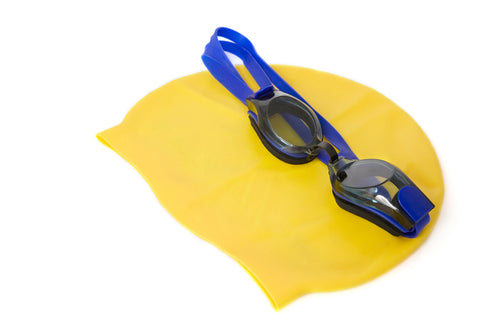
When selecting these items, comfort and a proper fit should be your top priorities. For swim goggles, opt for models that feature anti-fog and UV protection. Choose wetsuits that are form-fitting yet allow for free movement. Swim caps crafted from silicone or latex are preferred for their longevity and snug fit.
The foundation of your biking equipment is the selection of an appropriate bicycle. Road bicycles are engineered for quickness and efficiency on asphalt, making them the perfect fit for triathlon events. When selecting a bicycle, take into account the material of the frame, its size, and how well it fits you to ensure comfort throughout extended periods of cycling.
Key biking gear includes a helmet, cycling footwear, and biking attire. A helmet that fits well is essential for protection, whereas cycling shoes with a hard sole improve your pedaling efficiency. Biking attire should be light and capable of wicking away sweat to maintain your comfort. Opt for attire crafted specifically for biking, as it will include features like padded shorts for enhanced comfort during prolonged periods on the bike.
The selection of suitable running footwear is critical for comfort and to avoid injuries. Pay attention to the structure of your foot, the way you walk and run, and the kind of running activities you plan to engage in. It's advisable to visit a store specializing in running, where you can get a gait analysis and experiment with various brands and styles.
Beyond shoes, consider additional running accessories such as clothing that wicks away moisture to keep you dry, a cap or visor to shield you from the sun, and high-quality running socks to ward off blisters. For those who run when it's dark, reflective attire or a headlamp is recommended for visibility and safety.
By taking the time to choose the appropriate gear for swimming, biking, and running, you're laying the groundwork for improved performance and a more satisfying experience in each segment. Keep in mind, the right equipment does more than aid your physical endeavors; it also elevates your confidence as you train and compete.
Creating your own triathlon training plan requires a detailed and systematic approach to ensure you are adequately prepared for the challenge that awaits. There are many things that go into making an effective regimen, such as focusing on the basics of a triathlon training plan, the frequency of training for each discipline, the critical balance between training and recovery, and the pivotal role of brick workouts in your preparation.
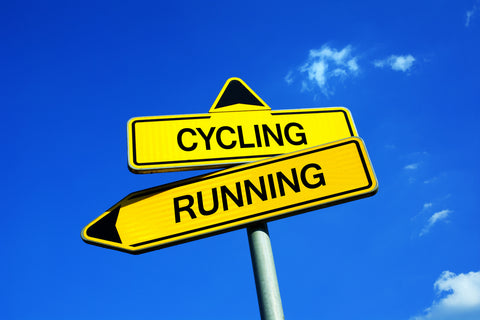
The foundation of any triathlon strategy is based on the three disciplines it comprises: swimming, cycling, and running. Each discipline demands unique physiological adaptations, making it crucial to develop a schedule that fosters improvement in all three areas.
Initially, your plan should outline the weekly frequency and duration of sessions dedicated to each sport. A balanced approach might include two to three sessions per discipline each week, depending on your current fitness level and specific triathlon goals.
When considering how often to train for each discipline, it's essential to listen to your body and recognize the signs of overtraining if they start to occur. Incorporating rest days and lighter training weeks into your plan is just as vital as the workouts themselves.
Recovery is when your body repairs and strengthens itself; thus, balancing training with adequate recovery is paramount. Overlooking this balance can lead to injuries and burnout, derailing your progress.
Then there’s the fact that the necessity of brick workouts cannot be overstated. These are sessions where you combine two disciplines back-to-back, most commonly cycling followed by running.
Brick workouts acclimate your body to the unique demands of transitioning between sports, improving both your physical and mental endurance. They teach your legs to run on tired muscles and prepare your mind for the immediate switch in discipline, which is an invaluable and mandatory aspect of triathlon racing.
Crafting a successful triathlon training plan involves a careful blend of discipline-specific training, recovery, and the strategic inclusion of brick workouts. By adhering to these guidelines, you can create a comprehensive and effective regimen that will prepare you for the rigors of triathlon competition, ensuring that you arrive at the starting line confident, conditioned, and ready to perform at your best.
As a triathlete, your body is your most precious asset, and how you fuel it can significantly impact your performance and recovery. This is why understanding the basics of nutrition tailored to the demands of triathlon training and competition is paramount.
Triathlons are grueling, requiring athletes to excel in all three disciplines. Your nutrition plan is not any way less important.
To begin with, your daily nutrition should be balanced, focusing on carbohydrates, proteins, and fats, alongside essential vitamins and minerals. Carbohydrates are your primary energy source, especially for high-intensity efforts, so they should constitute a significant portion of your diet. This is not the discipline to restrict or limit carbs, unless you are prepared to have your performance stall.
Proteins are crucial for muscle repair and recovery, while fats are important for long-duration energy needs. Incorporating a variety of fruits, vegetables, whole grains, lean proteins, and healthy fats will ensure you're receiving all the nutrients required for optimal performance and recovery.
We highly recommend you supplement your diet with Field Of Greens, loaded with phytonutrients and vitamins to ensure you get the most out of your nutrition plan.
Hydration is another major contributor to triathlon success. Dehydration can severely impair your performance and recovery, making it essential to stay adequately hydrated before, during, and after training and races.
Electrolyte balance is also crucial during longer or hotter events to prevent cramps and maintain muscle function. Therefore, integrating an electrolyte solution or drinks into your hydration plan is beneficial.
In the days leading up to the race, focus on carbohydrate-loading to maximize glycogen stores in your muscles. However, avoid heavy meals the night before the race to prevent digestive discomfort. A high-carb, low-fiber meal 2-3 hours before the race can provide the needed energy without upsetting your stomach.
During the race, your nutrition should aim to replenish the carbohydrates being used by your muscles. Energy gels, chews, and sports drinks are effective ways to maintain energy levels, especially during the bike and run segments. Remember to practice your nutrition strategy during training to avoid gastrointestinal issues on race day.
Post-race nutrition focuses on recovery. Aim to consume a mix of carbohydrates and proteins within 30 minutes after finishing to replenish energy stores and aid in muscle repair. Hydration should also continue post-race to replace any fluid losses.
A transition refers to the specific segments between the individual disciplines of swimming, cycling, and running that athletes must complete.
There are two main transitions in a triathlon: T1 and T2. T1, or Transition 1, occurs between the swimming and cycling portions of the race, where athletes change from their swim gear into their cycling gear.
This often involves drying off, putting on a helmet, cycling shoes, sunglasses, and sometimes changing entire outfits if the race conditions or rules require it.
T2, or Transition 2, happens between the cycling and running segments. Here, athletes switch from their cycling gear into their running gear, typically changing shoes and possibly shedding some cycling-specific equipment like helmets and sometimes even changing outfits for better comfort or performance during the run.
Transitions are often referred to as the "fourth discipline" in triathlon because they require planning, and practice to minimize time lost. A smooth transition can significantly affect an athlete's overall race time and position.
Not surprisingly, athletes spend considerable time practicing transitions, strategizing on the most efficient ways to change gear, and organizing their transition area for quick and smooth changes. The transition areas are pre-designated zones where athletes store their gear during the race, and understanding the layout and rules governing these areas also helps in making for a successful transition.
In many races, the transition time is included in the overall time of the athlete, making it even more critical to be efficient in this phase of the race. Some athletes may opt for gear that can be used across multiple segments to save time, such as wearing a tri-suit that is suitable for swimming, biking, and running, or using clip-on shoes that can be worn for both biking and running.
The setup of your transition area is more helpful than people give it credit for. This area acts as a mini-base where you switch from swimming to cycling gear (T1), and later from cycling to running gear (T2).
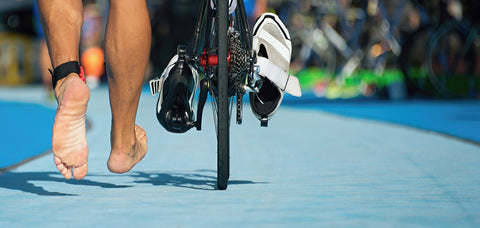
For an efficient setup, it's advisable to keep your gear organized and minimal. Place your cycling shoes, helmet, and sunglasses in an easily accessible position for T1. For T2, have your running shoes (with speed laces for quick tie-ups) ready, along with your race belt and hat if needed. Position items in the order you will use them, and practice your setup to ensure smooth transitions.
To excel in transitions, here are some indispensable tips:
Remember, transitions are often where races are won or lost. Just imagine the time that can be lost without properly coordinating your changes. By dedicating time to practice and optimizing your transition area and techniques, you can enhance your overall performance and enjoy a smoother, more successful race experience.
Doing a triathlon demands not only physical endurance but also a resilient mindset. The mental challenges of this multi-discipline sport are profound, stretching from the daunting anticipation before the race to the mental stamina required during it. You may find yourself wrestling with self-doubt, battling the urge to give up, or struggling to maintain focus over the long haul. However, by honing your mental fortitude, you can transform these challenges into stepping stones toward your ultimate triumph.
To build mental toughness, start by setting realistic yet, moderately challenging goals for each segment of your training and the race itself. Visualize your success in achieving these goals, immersing yourself in the feeling of crossing the finish line with your personal best time.

Implement positive self-talk, replacing negative thoughts with affirmations of your strength, preparation, and resilience. This mental rehearsal primes your brain for success, making the envisioned outcomes more attainable.
You also need to learn to embrace discomfort, and not shy away from it. Training sessions should not only push your physical limits but also get you accustomed to the mental strain of exertion and fatigue.
Seek out conditions that mimic those you'll face on race day—be it open water swims, hilly bike routes, or brick workouts—to build confidence in your ability to persevere. Remember, comfort zones are the most significant barriers to growth.
Pre-race nerves are an inevitable part of the triathlon experience, but they can be mitigated. Begin by establishing a consistent pre-race routine that calms and centers you. This might include mindfulness meditation, deep-breathing exercises, or listening to a playlist that energizes or motivates you.
On race day, focus on the process rather than the outcome. Break the race down into manageable segments, concentrating solely on the task at hand. This approach keeps overwhelming thoughts at bay and anchors you in the present moment.
View the race as an opportunity to test your limits, to celebrate the culmination of your hard work, and to enjoy the camaraderie of fellow athletes. By shifting your perspective, the anxiety transforms into a powerful motivator, propelling you forward with a sense of purpose and anticipation.
Congratulations on completing your triathlon—a testament to your strength, endurance, and dedication. However, the journey doesn't end at the finish line. Post-race recovery is a pivotal phase, too, not only for your physical well-being but also for your ongoing performance and preparation for future challenges. It's necessary to approach this period with as much care and planning as you did your training and race preparation.
After pushing your body to its limits, a comprehensive recovery strategy is essential to replenish depleted energy stores, repair muscle damage, and mitigate the risk of injury. This phase allows your body to adapt to the stress it has undergone, becoming stronger and more efficient in the process.
Neglecting proper recovery can lead to prolonged fatigue, decreased performance, and increased susceptibility to injuries and illnesses.
You might fancy that burger and shake or other indulgence, but immediately afterwards, the goal should be to re-introduce high quality nutrients.
Immediately after finishing, aim to consume a blend of carbohydrates and protein to kickstart the recovery process. Carbohydrates will replenish glycogen stores, while protein aids in muscle repair. A ratio of 3:1 (carbohydrates to protein) is often recommended. Foods such as a banana with almond butter or a recovery shake can be excellent choices.
In the days following the race, continue to focus on nutrient-dense foods. Incorporate a variety of fruits, vegetables, whole grains, lean proteins, and healthy fats into your meals. These nutrients will support muscle repair, reduce inflammation, and restore energy levels. Don’t forget to take collagen protein too, since your aching joints could use a little TLC at this time as well.
Hydration is equally important; replenish fluids by drinking water and electrolyte-balanced beverages to counteract any dehydration from the race.
Adequate rest is non-negotiable. In the first 24-48 hours post-race, prioritize sleep and avoid strenuous activities to give your body time to initiate the healing process. If you're antsy or feeling stiff, gentle, restorative movements such as walking or yoga can be beneficial—but listen to your body and don't push it.
After a couple of days, you can gradually introduce more structured active recovery sessions. Activities like swimming, cycling at a low intensity, or a light jog can enhance blood circulation, further helping with muscle repair and recovery. Remember, the key is low intensity, since the goal is to mobilize your muscles without placing additional stress on them.
Once you've begun to recover physically, take time to reflect on your race performance. Analyze both your strengths and areas for improvement. This reflection is not only about critiquing your performance but also about appreciating the journey and the effort you've put in. Celebrate your achievements, no matter how small they may seem.
Setting new goals is the next step. They could be related to improving certain aspects of your performance, tackling a longer distance, or even focusing on your recovery strategies. Whatever your goals, ensure they are SMART. This approach will keep you motivated and focused on your triathlon journey.
A triathlon is a significant undertaking- one that usually takes months of preparation to finally pull off. As a result, don't beat yourself too much if you find that things aren't moving as fast as you'd like.
It's always better to be overprepared than to go underprepared, especially as a triathlete. Take note of the tips we've highlighted and you should have a guide to assist you as you get ready to conquer your latest accomplishment.